 Land Based Learning
Land Based Learning
Course Content
Topic outline
-
 Bovine tuberculosis (bTB) is a chronic, infectious and primarily respiratory disease caused by the slow-growing bacterium Mycobacterium bovis (M. bovis).
Bovine tuberculosis (bTB) is a chronic, infectious and primarily respiratory disease caused by the slow-growing bacterium Mycobacterium bovis (M. bovis). It is a 'notifiable disease' and therefore if you suspect a case of bTB you must report to the APHA (Animal and Plant Health Authority)
If you suspect a notifiable disease in your animals you must report it immediately by calling the Defra Rural Services Helpline on 03000 200 301. In Wales, call 0300 303 8268. In Scotland, contact your local Field Services Office. Failure to do so is an offence.
Notifiable diseases in animals - GOV.UK (www.gov.uk)
bTB is mainly a disease of cattle and other bovines, but can affect a wide range of mammals.
The government is committed to implementing a comprehensive 25-year strategy to eradicate bTB in England.An independent review of the government's bTB strategy was carried out by Professor Godfray and his team and was published in November 2018. The government published its response to the review in March 2020, setting out its priorities for the next five years.
In 2021 The strategy was further strengthened to include:
- Work on badger vaccination, increased cattle testing and development of cattle vaccine to be accelerated
- Licensing of new intensive culls set to end after 2022 following a significant reduction in the disease
- New schemes launched to roll out badger vaccination across the country
Biosecurity
A key component of the bTB eradication strategy is implementation of a simple five point plan supporting the application of good biosecurity:
- Restrict contact between badgers and cattle
- Manage cattle feed and water
- Stop infected cattle entering the herd
- Reduce risk from neighbouring herds
- Minimise infection from cattle manure
This course is designed to provide background to these five points and the scientific principles that they are based on. Scroll down the course page and work through the content to find out more.
-
This first topic introduces some basic facts about bTB. Use the resources to develop your understanding of bTB and the government's strategy to eradication the disease in England.
It introduces the following topics:
- bTB facts
- Government policy on bTB
- The methods used by government to monitor, control and ultimately eradicate the disease
bTB Facts
Bovine TB (bTB) is caused by Mycobacterium bovis. Disease can be carried and spread by a variety of species including cattle, badgers, deer, alpacas, llamas, goats, cats and dogs. It is a zoonotic disease meaning humans can also become infected.
The majority of infections are picked up through bTB testing regularly conducted on cattle farms as part of a national animal health programme. The condition can take years to show clinical signs of infection.
NADIS - National Animal Disease Information Service
DEFRA guidance states you should look out for cattle that:
- keep getting thinner
- have a light fever that keeps coming back
- are weak and have a reduced appetite
Some infected cattle will also have:
- swollen lymph nodes, for example in the neck
- a moist cough that gets worse in the morning and during cold weather or exercise
- chronic mastitis (an infection of the udder that is not cured by the conventional antibiotic therapy)
Government Policy on bTB
Work to develop a vaccine for cattle and to vaccinate badgers is underway as new measures to eradicate bovine tuberculosis (bTB) in England by 2038.
The licensing of new intensive badger culls, which have effectively helped reduce bTB rates by half in certain areas, will cease after 2022.
In addition, existing cull licenses could be cut short after two years, down from five years, where supported by sufficient scientific evidence, and there will be no option for them to be renewed. The Government will develop a monitoring system to track the badger population and disease levels to help tackle the disease, with the findings being routinely published on gov.uk.
A five-year badger vaccination programme in East Sussex has been awarded £2.27 million to enable farmers to deploy vaccinations over an area of 250 square kilometres. The results of this trial will help inform the government on how to deploy future vaccination schemes at scale across England, halting the culling of this protected species.
Government sets out next phase of strategy to combat bovine tuberculosis in England - GOV.UK (www.gov.uk)Monitoring, Control and Eradication
Alongside a national testing programme, government continues to support understanding, prevention and eradication through the TB Hub website, detailing information on advice during a breakdown, prevention, TB in wildlife, TB in non-bovines.
TB hub - Bovine TB Advice & Tuberculosis Information for Cattle Farmers
-
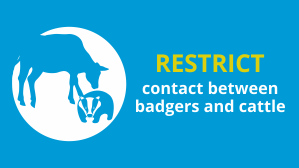
This topic introduces ways to restrict contact between badgers and cattle both in farm buildings and at pasture. It is made up of a series of resources for you to use to develop your understanding of the methods used to keep badgers and cattle apart.
It introduces the following topics:
- Badger ecology and how you can identify if badgers are present on a farm
- The basic principles of biosecurity
- The measures that can be used to prevent badgers accessing farm buildings
- The measures that can be used to limit contact between cattle and badgers at pasture
Click on the link to find out more:
Restrict contact between badgers and cattle - Bovine TB | TB Hub
-
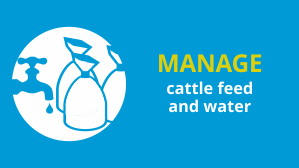
This topic introduces how to manage cattle feed and water on farm. It is made up of resources for you to use to develop your understanding of the methods used to prevent contamination of cattle feed and water with bTB.
It introduces the following topics:
- Badgers and cattle feeds
- Restricting badger access to feed stores
- Feeding techniques to minimise contamination
- Drinking water management
Click on the link below to find out more.
-
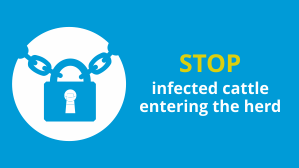
Movement of cattle is the most significant route for spreading bTB. This topic introduces the different options for trading cattle and the ways in which bTB can enter the herd. It is made up of resources to help you develop your understanding of the methods used to prevent infected cattle entering a herd.
It introduces the following topics:
- The questions to ask about a herd's bTB history before buying
- Pre and post movement testing requirements
- Isolation methods
- Cattle trading
Click on the links below to find out more:
-

This topic introduces ways of reducing the risk of bTB infection from neighbouring cattle herds. It is made up of resources to help you develop your understanding of the risks that neighbouring herds pose and the ways in which this risk can be reduced.
It introduces the following topics:
- How to check the local bTB situation
- How to establish effective barriers between cattle herds
- The risks of sharing equipment and how these can be minimised
Click on the link below to find out more:
-
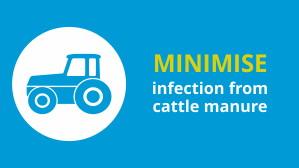
This topic introduces the measures used to minimise infection from cattle manure. It is made up of resources to help you develop your understanding of the risks posed by infected manure and the methods that can be uses to minimise the risk.
It introduces the following topics:
- TB and manure
- How to reduce the risk from manure
- The risks from spreading manure and how these can be minimised
Click on the link below to find out more:
Minimise infection from cattle manure - Bovine TB | TB Hub -
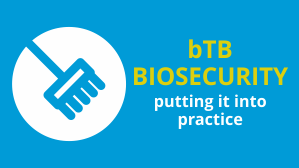 By now you should have developed an understanding of the facts about bTB and how by following Defra's five point plan it is possible to maintain good biosecurity and limit the potential impact of bTB by:
By now you should have developed an understanding of the facts about bTB and how by following Defra's five point plan it is possible to maintain good biosecurity and limit the potential impact of bTB by:Restricting contact between badgers and cattle
Managing cattle feed and water
Stopping infected cattle entering the herd
Reducing the risk from neighbouring herds
Minimising infection from cattle manureIn this final section of the course we aim to provide you with an opportunity to put you knowledge and skills into practice. Complete the activity below where you will be required to review some published case studies and comment on the measures that have been implemented. Click on the link below to complete the activity.